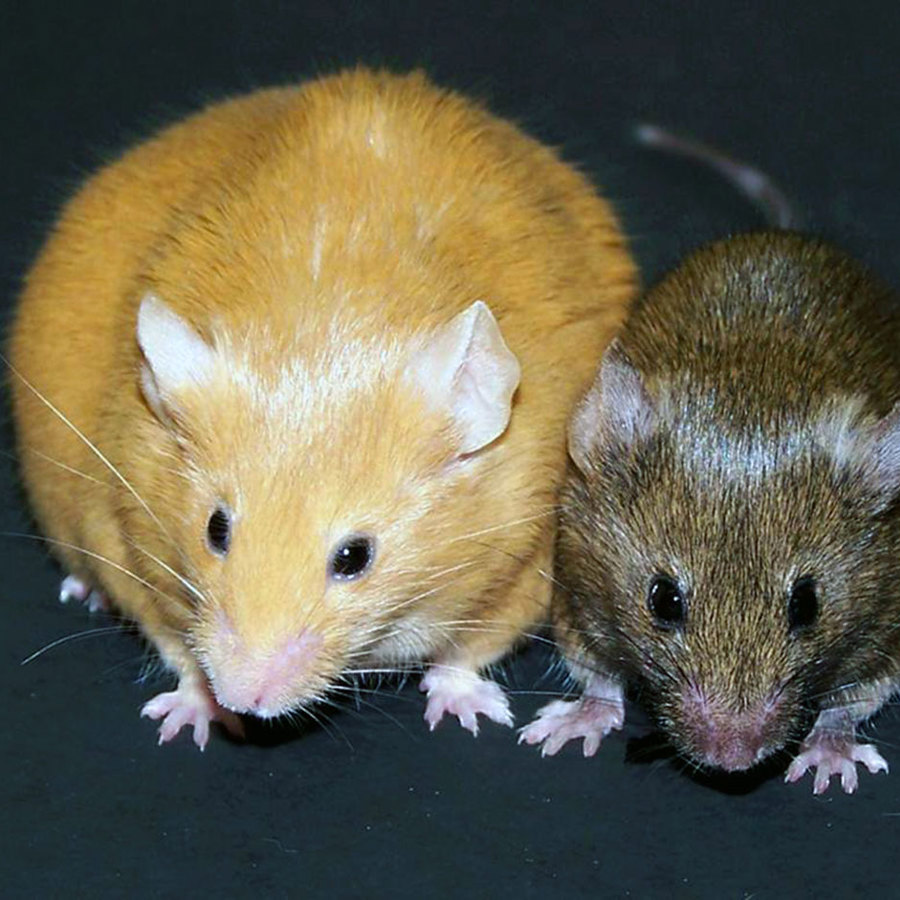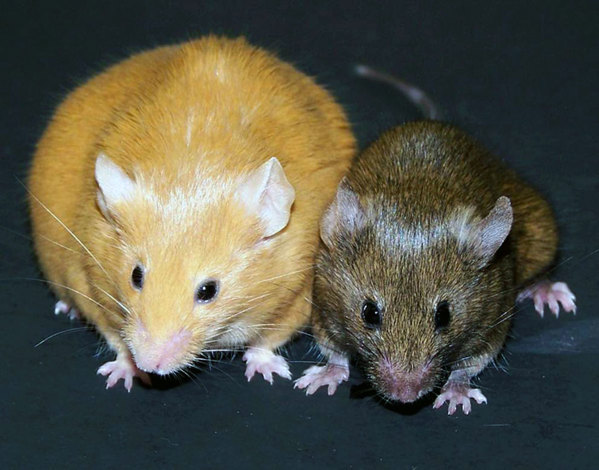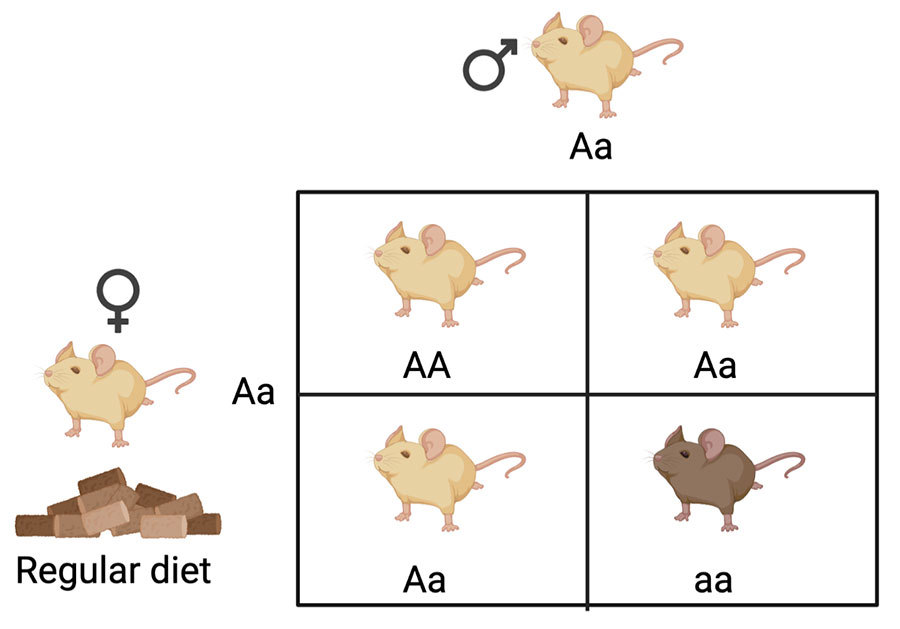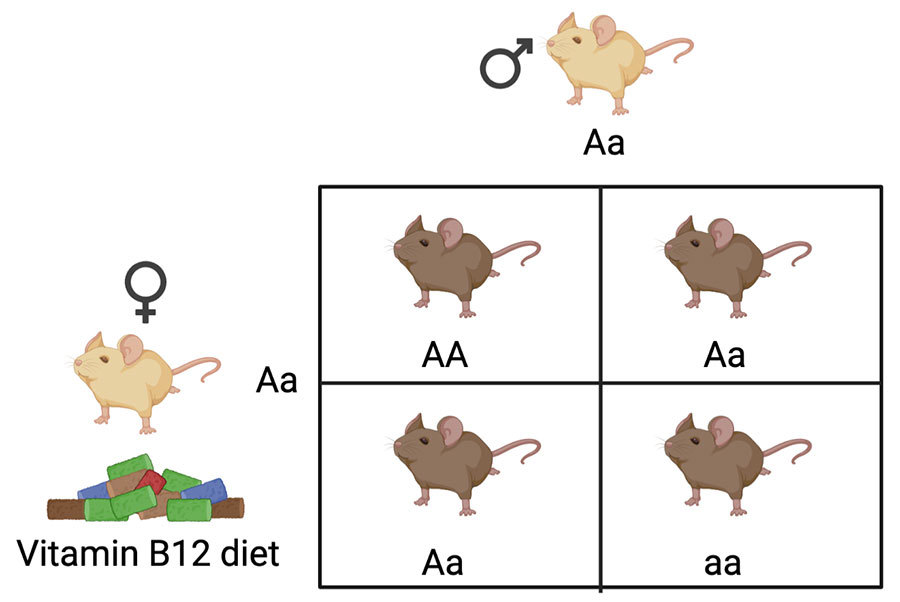
Can yellow mice have brown pups?
April 7, 2011

- Related Topics:
- Epigenetics,
- Environmental influence,
- Gene expression,
- Punnett squares
An undergraduate from Utah asks:
“Can yellow, obese agouti mice have brown pups or are they all yellow?”
Yes: fat, yellow agouti mice can have thin brown pups. Even if their genes make it look impossible.
How can the pups be brown when their genes tell them to be yellow? It could be that the environment marks the genes involved and changes how they work.
Before getting into this, let’s first talk about the genes involved in determining if pups end up yellow or brown. Then we can delve deeper into how the environment can change how a gene works.

Yellow is Dominant
Agouti is one of the key genes involved in making a mouse brown or yellow. Small differences in the versions of the agouti gene cause differences in colors or hair patterns. So one version, the dominant agouti gene (denoted “A”), directs cells to make the yellow pigment and the recessive version (denoted “a”), tells them to make a brown pigment instead.
This leads us to a simple explanation for how genes alone could make a yellow agouti mouse have brown pups. Remember, each cell carries two copies of the agouti gene and these needn’t be identical. As long as there's one copy of the dominant A form, a mouse’s fur is yellow. So an agouti mouse could have either AA or Aa, and it would be yellow. But pups get one copy of their agouti gene from each of their parents.
If an agouti mom is AA, she will always pass on the dominant (yellow) form of the gene to her pups. So they’d always be yellow. (Well, almost always. See below for how exceptions to this rule can happen.)
But if the mom is Aa, then each pup has a 50% chance of getting the brown recessive ‘a’ gene. If the father is also Aa, then each pup has a 25% chance of getting the ‘a’ version from both parents. These pups will be aa and so be brown. If the father is not agouti at all but brown (aa), each pup has a 1 in 2 chance (50%) of being brown.

This probably isn’t why you asked the question though. Agouti mice are so interesting because what a pregnant mouse eats can affect the color of her pups. This is true even if the pup is AA and so should be yellow.
Shutting off Yellow
Sometimes a brown mouse has genes which should make it yellow. These mice end up brown because environmental or “epigenetic” factors influence the agouti gene.
Epigenetic factors are external influences like food, stress, behavior, and toxins from around us. These can cause chemical changes in DNA that change the way genes give cells their instructions. Think of DNA like a charm bracelet. So the DNA itself is the bracelet, and epigenetic factors change the charms, or different chemical groups, that hang off of it.
For example, scientists have found that changing the diet and toxins that pregnant mice are exposed to can change the expression of the agouti gene in their pups. So in addition to the genes the moms hand down to their offspring, they also pass an “epigenome” along. And the epigenome depends on what the moms are exposed to in their environment.
When scientists fed pregnant yellow mice diets rich in nutrients containing methyl-groups, like folic acid and vitamin B12, the agouti gene in pups got switched off. The pups from such mice were brown and thin, not fat and yellow.

They also found that a common chemical called BPA (Bisphenol A) could turn the agouti gene on. When pregnant yellow mice were exposed to BPA, they had more yellow, unhealthy pups. But when they made these BPA-exposed pregnant mice eat more methyl-rich foods, the effects on the pups were reversed, and there were more brown pups than yellow.1
How can diet and toxins change the agouti gene? The methyl groups in the vitamins are the bracelet charms we talked about earlier. They attach to the DNA sequence in genes and change the way cells read the instructions in the genes. So the stuff that parents (and even grandparents!) eat or experience can change the way their kids’ genes behave.
For the rest of this answer, I thought we’d look at how the epigenome turns genes on and off, and how it can get passed on from one generation to the next.
Epigenetics: The Other Half of the Genome
The epigenome is what cells use to decide which gene to use when. When chemical groups are added to the DNA, like the methyl groups on the agouti gene, they can do one of two things. They can either turn a gene on or switch it off.

How can the same methyl groups do both things? The answer has to do with the fact that DNA is so tightly coiled inside cells.
For the instructions in a gene to be read and used, the cell’s machinery has to be able to access it. Chemical tags on the DNA can help uncoil it so that certain genes are accessible. Or, they can sit on top of the genes and cover them up. It’s something like covering a line of instructions with your hand so no one can read it versus pointing to the words with your finger so that they’re easier to find.
Epigenetic tags can affect different genes in different ways. So the same tag might activate one gene but inactivate another. Other chemical groups or cellular proteins can attach temporarily and detach when they’re not needed. And some tags can stick on DNA even as it gets passed on from a parent cell to daughter cells.
Some epigenetic effects can last for multiple generations. For example, babies born during a famine after World War II had poorer health than usual, which wasn’t unexpected. But scientists found that the grandchildren of those babies also had a tendency to develop poor health.2
It’s important to remember that this isn’t the same as a genetic change. The famine didn’t cause mutations in genes. The change in food only changed the way cells used the instructions that their genes carried.
Epigenetic interactions are just one of the reasons genes don’t always behave the way we would expect from our textbooks. The agouti gene is just one of the examples of how epigenetic effects can change the instructions that genes give cells.
Diet, lifestyle, and even our grandparents’ experiences can change the way genes behave. You can read more about mouse coat colors and epigenetic effects at the links that follow.
Read More:
- Jax: The Coat Colors of Mice
- YouTube: TED-Ed: What is Epigenetics?
- Scitable: Obesity, Epigenetics, and Gene Regulation

Author: Dr. Jyoti Madhusoodanan
Dr. Madhusoodanan wrote this article while participating in the Stanford at the Tech program.
 Skip Navigation
Skip Navigation
